|
|
|||
|
(Back to Preceding Week; on to Next Week) |
|
HUMMINGBIRD PREDATORS
When we give our "Hummingbird Mornings" presentations around the country, we get interesting questions from the audience. Seems like folks always want to know how long a hummer lives (the record for a Ruby-throated Hummingbird is nine years), whether the same bird ever comes back to the same site year after year (we've had RTHU return to Hilton Pond Center five years in a row after banding), how female hummers feed their young (by regurgitating a slurry of nectar and tiny insects), and how to find a hummingbird nest (don't ask us because we never have). Invariably someone also asks if hummingbirds have any ENEMIES, to which we usually reply that a hummer's worst enemy is us humans. By destroying habitat, by erecting buildings and towers in the middle of migratory paths, by installing nearly invisible glass windows and patio doors in our houses, by overusing pesticides and unleashing other chemicals into the environment, by leaving garage doors open, and by running into birds while driving our motor vehicles, each year we humans kill tens of thousands of hummingbirds--perhaps far more. This sort of news, we hope, educates and alarms the audience sufficiently that they will take whatever action they can to minimize human-generated dangers to hummingbirds.
Sometimes an audience member will ask instead whether hummingbirds have any PREDATORS, to which we again reply that humans play a role--principally by allowing feral cats to hang out where hummers feed and nest. Most people--Pablo Picasso (above) not included--seem shocked to learn that free-roaming cats can kill hummers and that we have actually seen video of house cats sitting on deck railings swatting at hummers coming to a backyard feeder. Cats do indeed kill hummers and countless other birds and small animals, but they are not NATURAL predators on hummingbirds. In fact, very few animals are fast enough to catch a hummer and consume it, so we ask the audience to guess what might be on the short list of creatures able to capture hummers. Different audiences provide different conjecture, but folks usually come up with at least some of the hummingbird predators that have been described in the scientific literature. People sometimes guess correctly that hummingbird eggs and chicks are taken--albeit rarely--by arboreal snakes such as young Black Ratsnakes, and that Eastern Chipmunks and Eastern Gray Squirrels may do the same. We suspect such predation is relatively uncommon, however, because most successful hummer nests are at the ends of branches not strong enough to support a predator's weight.
All text & photos © Hilton Pond Center Particularly swift Sharp-shinned Hawks (above)--undoubtedly adults who have polished their hunting skills--have been observed taking free-flying hummingbirds, as have Loggerhead Shrikes. Both these species are known for preying on other birds, so it shouldn't be much of a surprise that they could and would sometimes take a hummer. Other avian predators of hummingbirds include herons and egrets--to which hummers probably look like large insects--and the occasional jay, grackle, gull, oriole, tanager, roadrunner, or large flycatcher.
Orbweaver Spiders--particularly Black-and-yellow Argiopes and even larger Golden Silk Orbweavers--can snare hummingbirds in their expansive webs, and through the years we've heard from a few homeowners who were able to gently untangle and release hummers from such silken traps. In the tropics "our" Ruby-throated Hummingbirds are captured by even larger spiders whose webs we imitate when we string mist nets to snare hummers for banding. (NOTE: Don't harm these spiders just because their webs may on rare occasions wrap up a hummer; if you have qualms, re-locate the spider, but don't kill it. Orbweavers are part of the natural scheme AND play a major role in capturing insect pests.)
Another arthropod predator reported to take hummingbirds has been documented in several photos that have traveled widely on the Internet. We refer here to the praying mantis, most specifically the big Chinese Mantid, Tenodera aridifolia sinensis, imported from Asia for release in gardens as a predator on insects that eat ornamental plants. It seems these foreign interlopers do rarely grab and kill hummingbirds with their spine-lined forelegs and consume part of the carcass. Some folks have gotten quite alarmed by this mantid-hummingbird predator-prey relationship and have taken to getting rid of all mantids. Suffice it to say our native species such as the Carolina Mantid, Stagmomantis carolina, are far too small to capture a hummer and should be protected as they go about their important business of killing agricultural pests. (Besides, The Carolina Mantid is South Carolina's state insect.)
There are also accounts in the literature of hummingbirds found in the stomachs of Largemouth Bass and Bullfrogs, and we personally witnessed an incident described last week of a Green Frog (above) jumping from our water garden at Hilton Pond Center as it unsuccessfully tried to pick off a considerably faster juvenile ruby-throat. We've also seen a photo of a free-floating Leopard Frog in California with a mouthful of hummingbird; again, this should not be surprising because all these frogs eat dragonflies that are nearly hummingbird size--although we bet the Leopard Frog had a rough time trying to swallow a hummer.
And speaking of dragonflies, there is a published reference to the big four-inch-long Common Green Darner, Anax junius (male, above), dragging a hummingbird to the ground and then flying off with it. We've always been suspicious of this particular account because we couldn't imagine a dragonfly ascending with a hummingbird that, although quite small, still probably outweighs our biggest dragonflies two-to-one. However, our suspicions of insect predation on hummingbirds diminished somewhat this week when we got an almost-unbelievable E-mail from a couple of old friends who live in Columbus NC.
We first met Buren and Luanne Blankenship in November 2000 when we visited their home in Pendleton SC to band a winter vagrant Rufous Hummingbird. We rekindled the relationship in October (above) and December 2003 after the couple moved just over the border to Columbus, where somehow they managed to host two MORE Rufous we trapped and banded. Luanne is a Master Gardener whose backyard is a veritable nectar paradise, but we've always wondered whether Buren's vocation as a pastor gives him some sort of edge that brings in vagrant hummers. On 6 September 2007, as he was in his study at work on the next Sunday sermon, Buren was distracted by a ruckus outside the house. The sound came from two rooms away and through an open screen door that led to the backyard patio where many of Luanne's container plants flourish. Buren said the clamor reminded him of a baby whimpering, so he alerted Luanne and they both rushed outside. It turns out the noise was being made by an adult male Ruby-throated Hummingbird, whose bright red gorget the Blankenships could clearly see because the bird was on its back--pinned down to the patio floor by a large insect! Instinctively, Luanne grabbed the vocal but helpless hummer and swatted off the insect, which she instantly stomped into the concrete. As the hummingbird sat in her hand, Luanne and Buren could see there was a hole in the plumage on top of the bird's head. Other than that, the hummer seemed none the worse for wear and soon zipped way to a nearby tree.
After this unusual experience, the Blankenships went back to look at what was left of the insect, whose parts were already being visited by a colony of ants. Buren took a photo he forwarded on to us via E-mail (above), and we concurred with his and Luanne's conclusion the Ruby-throated Hummingbird had been attacked by one of the large Robber Flies. The bad news is Luanne's merciful foot-stomping was so effective we at first were unable to identify the fly to species level, but . . .
. . . the good news is Buren was able to use a butterfly net to capture another identical fly specimen he pinned out (above) and photographed for us. From this we got a positive ID: Promachus rufipes, the Red-footed Cannibalfly.
Buren's later photos clearly show the Robber Fly's long legs. With these wrapped around the wings and body of the hummingbird, it's understandable the hummer wasn't able to fly--especially when we see the insect is almost four centimeters long (above)--approximately half the length of an adult male Ruby-throated Hummingbird. (See photo below of a museum specimen of a male ruby-throat, followed by the Robber Fly photo reduced to the same scale.)
After an extensive Internet search, we were able to find only one reference--on the TexBirds listserv--of a hummingbird succumbing to a Robber Fly. Ed Johnson posted this account on 8 September 2006:
Luanne, in a well-meaning but ill-fated attempt to understand the Robber Fly's predatory abilities, tells us:
Robber Flies (Family Asilidae) make up one of the biggest and most widely distributed insect groups in the world, with more than 7,000 species--some dating as far back as the Eocene Epoch (54.8 to 33.7 million years ago). We've seen several modern-day Robber Fly species here at Hilton Pond Center, including the Red-footed Cannibalfly. Asilids are among the largest of all flies, but until Buren and Luanne Blankenship reported this week's incident we NEVER would have thought any Robber Fly species would be big enough to take down a Ruby-throated Hummingbird. All text & photos © Hilton Pond Center
Comments or questions about this week's installment?
Thanks to the following fine folks for recent gifts in support of Hilton Pond Center for Piedmont Natural History and/or Operation RubyThroat: The Hummingbird Project. Your tax-deductible contributions allow us to continue writing, photographing, and sharing "This Week at Hilton Pond." (Please see Support if you'd like to make a gift of your own.)
IMPORTANT NOTE: If you ever shop on-line, you may be interested in becoming a member of iGive, through which nearly 700 on-line stores from Barnes and Noble to Lands' End will donate a percentage of your purchase price in support of Hilton Pond Center and Operation RubyThroat. For every new member who signs up and makes an on-line purchase iGive will donate an ADDITIONAL $5 to the Center. Please sign up by going to the iGive Web site. It's a painless, important way for YOU to support our work in conservation, education, and research. "This Week at Hilton Pond" is written & photographed You may wish to consult our Index of all nature topics covered since February 2000. You can also use our on-line Hilton Pond Search Engine at the bottom of this page. For a free, non-fattening, on-line subscription to |



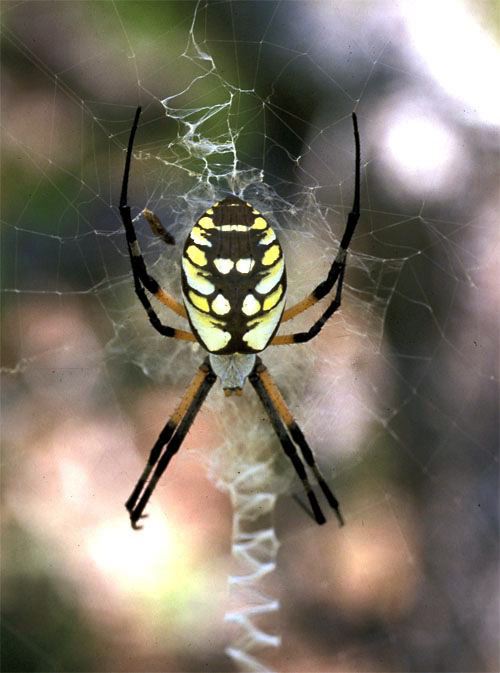
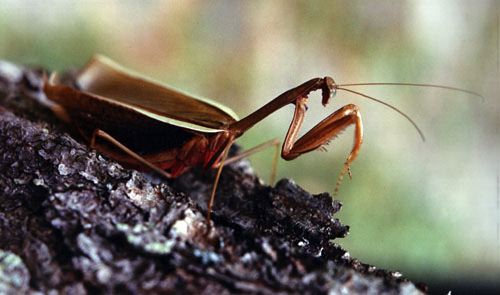
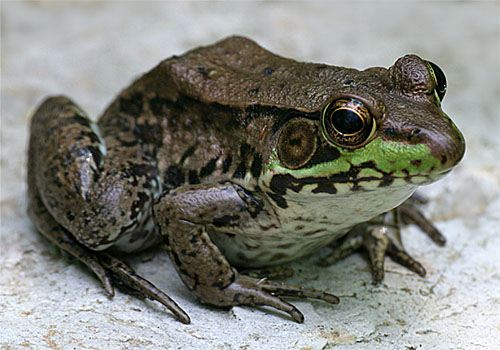
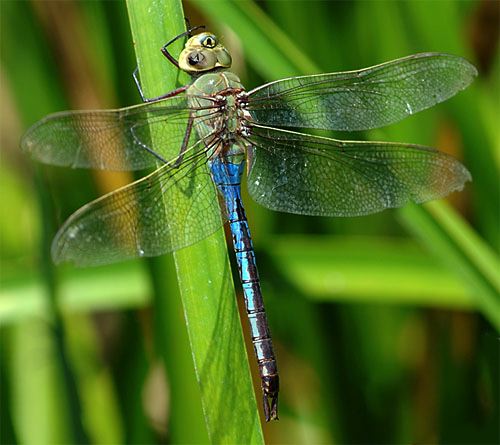

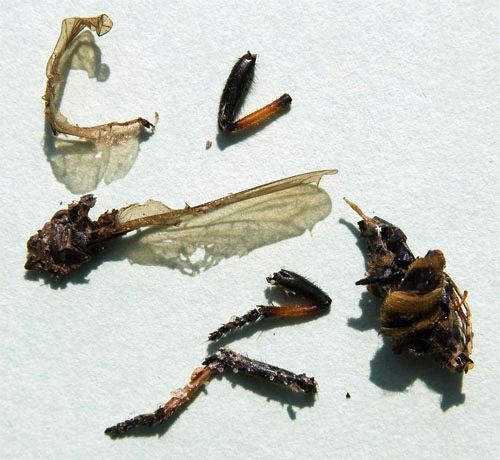

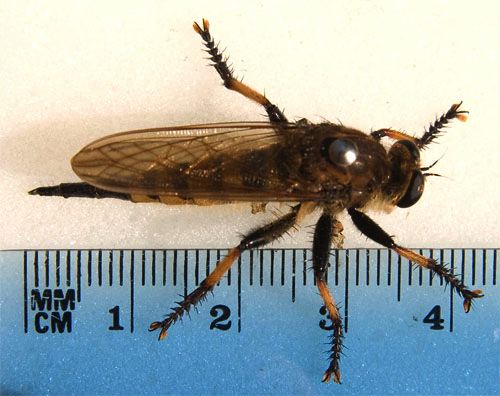
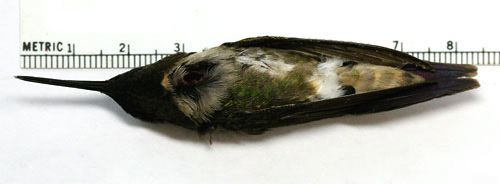
 The Red-footed Cannibalfly that attacked the Blankenships' North Carolina hummingbird has an alternate common name--the "Bee Panther"--that reveals it, too, more commonly preys upon bees, wasps, dragonflies, grasshoppers, and other insects (including smaller Robber Flies). All Robber Flies--including, at right, a smaller species (probably Ommatius sp.) dining on a flying ant--have a short, stiff proboscis they plunge into prey items; they simultaneously inject a cocktail of enzymes that paralyze and digest the victim, after which the hungry Robber Fly simply sucks out the prey's body fluids. We can only assume this is what would have happened to the Blankenships' hummingbird had Luanne and Buren not interceded, although we doubt the Robber Fly could have consumed the entire hummer. (QUERY: We note the fly in the photo above right is dining through the head of the ant. Was the hole in the hummer's head plumage coincidental, or did it mean the Robber Fly was trying to penetrate the thin bones of the bird's skull to digest and consume its cranial contents?)
The Red-footed Cannibalfly that attacked the Blankenships' North Carolina hummingbird has an alternate common name--the "Bee Panther"--that reveals it, too, more commonly preys upon bees, wasps, dragonflies, grasshoppers, and other insects (including smaller Robber Flies). All Robber Flies--including, at right, a smaller species (probably Ommatius sp.) dining on a flying ant--have a short, stiff proboscis they plunge into prey items; they simultaneously inject a cocktail of enzymes that paralyze and digest the victim, after which the hungry Robber Fly simply sucks out the prey's body fluids. We can only assume this is what would have happened to the Blankenships' hummingbird had Luanne and Buren not interceded, although we doubt the Robber Fly could have consumed the entire hummer. (QUERY: We note the fly in the photo above right is dining through the head of the ant. Was the hole in the hummer's head plumage coincidental, or did it mean the Robber Fly was trying to penetrate the thin bones of the bird's skull to digest and consume its cranial contents?)

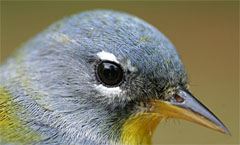
 Please report your
Please report your
